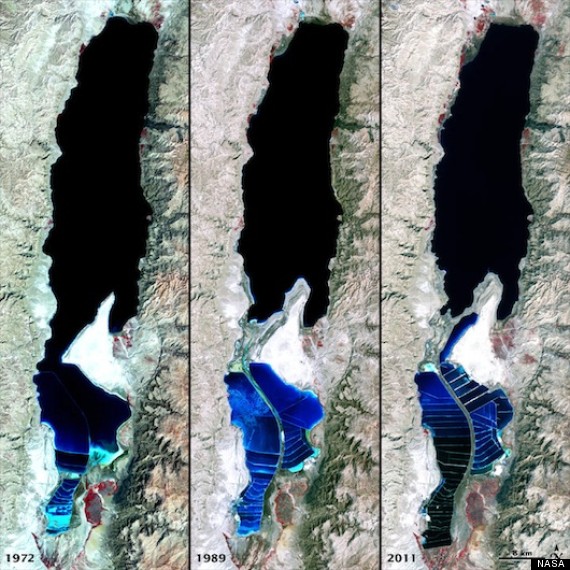
The Dead Sea earned its name not from death exactly, but from a relative lack of life. That's because, as a hypersaline lake, its water is far too salty for most wildlife to live there full-time (aside from recently discovered microbes on its seafloor).
But as the satellite images above illustrate, the Dead Sea itself has been gradually dying for decades. The trio of false-color images were taken at three points over the past 40 years — 1972, 1989 and 2011 — and reveal a dramatic transformation.
Captured by NASA's Landsat satellites, these images show deep waters as dark blue and shallow waters as bright blue, while pink and tan represent barren desert, green indicates sparse vegetation, and red indicates dense vegetation. Near the center is the Lisan Peninsula, which now forms a land bridge across the Dead Sea.
So why is the Dead Sea becoming smaller and shallower? Largely because of water diversions from the Jordan River, which flows into the Dead Sea from the north. But as NASA explains, intensive salt-gathering projects are also encroaching from the south — and they're especially obvious in these photos. According to NASA:
The ancient Egyptians used salts from the Dead Sea for mummification, fertilizers, and potash (a potassium-based salt). In the modern age, sodium chloride and potassium salts culled from the sea are used for water conditioning, road de-icing, and the manufacturing of polyvinyl chloride (PVC) plastics. The expansion of massive salt evaporation projects are clearly visible over the span of 39 years.
The Dead Sea is part of a depression in the Earth's crust between Africa and Asia, found on a rift where the two continents are pulling apart. It's the lowest surface feature anywhere on Earth, with shores located 1,300 feet below sea level. And thanks to its extreme saltiness, it's also known for its buoyancy: Delighted tourists float on its surface with ease, while frustrated divers struggle to explore its depths.
Jordan, Israel and the Palestinian Authority are currently planning redevelopment projects to save the Dead Sea, partly by pumping water from the Red Sea via pipelines. Jordan's project is slated to begin in early 2013, the Jordan Times reports, eventually moving 2.1 billion cubic meters of water from the Red Sea annually.
But the Dead Sea itself isn't the only regional treasure undergoing rehab. The Dead Sea Scrolls — a series of 972 biblical texts discovered around the sea between 1947 and 1956 — are being reanalyzed by facial-recognition software, which may help scholars better understand the scrolls' significance. And in the meantime, you can study them for yourself, thanks to a joint project by Google and the Israel Museum that recently digitized some of the scrolls and put them online.